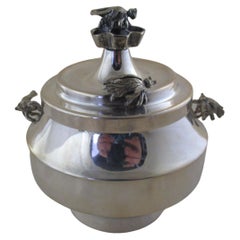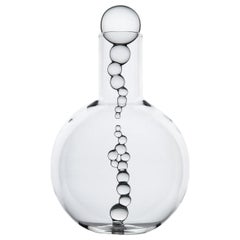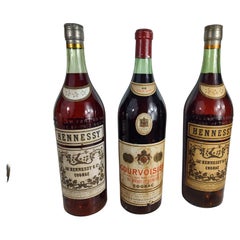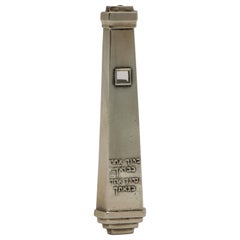Israeli Furniture
3
to
2
3
3
3
103
81
9
6
6
4
3
2
2
1
3
1
1
1
2
2
1
1
1
2,922
30,270
14,410
4,333
3,925
1
Style: Art Deco
Place of Origin: Israeli
Judaica silver liquor bottle by HAZORFIM
By Hazorfim
Located in Autonomous City Buenos Aires, CABA
Judaica silver liquor bottle by HAZORFIM
Beautiful silver bottle with a thin neck that widens towards the base, it has an ornamental design of bunches of grapes
Measures:
Height:14.5...
Category
20th Century Art Deco Israeli Furniture
Materials
Sterling Silver
Wall Carpet Produced by the Alliance School Crafts "Torah U'melakhah" Jerusalem
Located in Firenze, IT
Small wall carpet produced by the Weaving Department of the "Torah U'Melakhah" Covenant School of Crafts [Jerusalem, ca. 1920] with a portrait of Max Nordau...
Category
1920s Art Deco Vintage Israeli Furniture
Materials
Cotton
Sterling Silver Lidded Honey Pot & Liner with 4 Bees, Made in Israel
Located in York, GB
Sterling Silver LIDDED HONEY POT Made in Israel
A delightful honey pot decorated with four bees and a piece of honey comb.
The baluster shaped base has two bees - one on each side. They are a bit small for handles, but they will prevent the pot from slipping through the fingers.
The lid sits securely on the pot and has a notch to one side to hold the honey spoon...
Category
Mid-20th Century Art Deco Israeli Furniture
Materials
Silver
Related Items
Modern Alchemica Hand-Blown Glass Liquor Bottle
By Simone Crestani
Located in Camisano Vicentino, IT
"Modern Alchemica Hand-Blown Glass Liquor Bottle" by Simone Crestani
Introducing the Alchemica Bottle, a mesmerizing fusion of art and functionality meticulously crafted by the visionary glass artist Simone Crestani. As a cherished addition to the illustrious Alchemica Collection...
Category
21st Century and Contemporary Modern Israeli Furniture
Materials
Glass
Mid-Century Liquor Wine Display Bottle Blown Glass
Located in Port Jervis, NY
Fabulous display bottles from the fifties. Solid glass and painted on the inside to look like the bottle is full. COURVOISIER the brandy of Napoleon. HENNESSY cognac. Priced and sold...
Category
1950s Industrial Vintage Israeli Furniture
Materials
Blown Glass
Vintage Mid Century Glass French Wine Liquor Display Bottle
Located in Port Jervis, NY
Fabulous glass display bottles from the mid century era. Byrrh wine appertif is 21.5 height x 5.75 diameter. All are glass and in very good condition. Price is for each bottle. Bottl...
Category
1950s Art Deco Vintage Israeli Furniture
Materials
Glass
Art Deco Chinese Carpet by Nichols & Co.
Located in Milan, IT
Only a very limited group of the carpets woven during the thirties at the Tianjin city looms are decorated by geometric patterns typical of the Art Deco period. Some of these rare pi...
Category
1920s Art Deco Vintage Israeli Furniture
Materials
Wool
Contemporary Deer Hand-Blown Glass Liquor Bottle
By Simone Crestani
Located in Camisano Vicentino, IT
"Contemporary Deer Hand-Blown Glass Liquor Bottle" by Simone Crestani
Introducing the Deer Bottle, a magnificent testament to the wonders of nature meticulously crafted by the acclaimed glass artist Simone Crestani. As a cherished addition to the prestigious Trophy Bottles...
Category
21st Century and Contemporary Modern Israeli Furniture
Materials
Glass
Contemporary Longhorn Hand-Blown Glass Liquor Bottle
By Simone Crestani
Located in Camisano Vicentino, IT
"Contemporary Longhorn Hand-Blown Glass Liquor Bottle " by Simone Crestani
Introducing the Longhorn Bottle, a breathtaking masterpiece crafted by the visionary glass artist Simone Crestani. As a part of the esteemed Trophy Bottles...
Category
21st Century and Contemporary Modern Israeli Furniture
Materials
Glass
Sterling 925 silver beehive honey pot with a spoon
Located in Braintree, GB
Sterling 925 silver beehive honey pot with a spoon.
Made in 2022, spoon made in 2021.
The beehive honey pot, adorned with decorative bees, features t...
Category
2010s Israeli Furniture
Materials
Silver
Nice Baccarat Crystal and Jacques Adnet Liquor Bottles Set
By Jacques Adnet, Baccarat
Located in Brussels, BE
Nice Baccarat crystal and Jacques Adnet liquor bottles set, circa 1930.
In perfect and original conditions. With key.
Category
1930s Art Deco Vintage Israeli Furniture
Materials
Crystal, Metal
Persian Silk Heriz Carpet, circa 1870
Located in Port Washington, NY
Antique Heriz wool carpets are renowned for their crisp, abstract geometric interpretation of classical Persian rug design. Heriz carpets woven in silk, however, are quite distinct a...
Category
Late 19th Century Antique Israeli Furniture
Materials
Silk
Danish 1940s Salt Glazed Liquor Bottle Vase
Located in Copenhagen, DK
Decorative stoneware bottle vase originally used for alcoholic liquor in Denmark in the 1940s. Thick light grey salt glaze with baby blue specks along the handle and sides. Asymmetri...
Category
Mid-20th Century Mid-Century Modern Israeli Furniture
Materials
Ceramic, Stoneware
Mappin & Webb Sterling Silver Footed Mustard Pot with Glass Liner, Circa 1929
By Mappin & Webb
Located in Miami Beach, FL
This beautiful ornate example of a mustard pot by famed Birmingham England silversmith Mappin and Webb was manufactured in 1929. The rim has a scolloped ribbon edge. It then bows out...
Category
Early 20th Century Israeli Furniture
Materials
Sterling Silver
H 2.5 in W 4 in D 2.8 in
Biedermeier Style Bohemian Cut And Ground Crystal Liquor Bottle
Located in Prato, Tuscany
We kindly suggest that you read the entire description, as with it we try to give you detailed technical and historical information to guarantee the authenticity of our objects.
Hand...
Category
Early 20th Century Biedermeier Israeli Furniture
Materials
Crystal
Previously Available Items
Vintage Israeli Brass Menorah Chanukah Candleholder with Turquoise Stone
Located in Esbjerg, DK
Small intricate brass Chanukah Candelabra manufactured by Tamar in Israel in 1966. Distinct and characteristic Art Deco revival styling. Hand-painted and jeweled with a turquoise sto...
Category
1960s Art Deco Vintage Israeli Furniture
Materials
Stone, Brass
H 5.71 in W 9.85 in D 1.78 in
Early 20th Century Silver Mezuzah by Avraham Moshe Sokolka, Jerusalem
Located in New York, NY
Massive and heavy silver Mezuzah by Avraham Moshe Sokolka, Jerusalem, circa 1929.
Designed in Art Deco style with a small opening to see the parchment inside.
Inscribed in Hebrew: "You will be blessed when you come in and blessed when you go out"
Marked on the back in English: "Sokolka, Made in Palestine, Jerusalem, silver, marked in Hebrew: "Eretz Israel"
Moshe Avraham Sokolka was born in Vistnitz, Poland, on September 3, 1880, to Yitzhak Yaakov Sokolka, educated cigar merchant and a devoted Zionist from the time of Chovevei Zion, and his wife Chaia Miriam Ramberg.
After completing with honors 14 years of cheder (Jewish day school) education, he had to choose to learn a trade. Considering his talents, he was offered the opportunity to learn to be a watchmaker or a jeweler. Watchmaking was not an option for the young boy. In Warsaw at the end of the 19th century, a watchmaker did repairs and was a petty trader. The boy had bigger aspirations. He became a student and apprentice in a jewelry workshop that was manufacturing jewelry and objects d’art in precious metals. He excelled and had a great reputation in his artistic achievements. At age 27, he married Sara Hannah Ramberg and the couple made Warsaw their home. While in Warsaw, he continued his Zionist activities and founded the youth movement “Ovdi Tzion.” One of its goals was to sell Jewish Colonial Trust bonds “Otzar Ha’Hityashvot Ha’Yehudit” among the population, in installments of 20 Kupekot a week. He served as a secretary of Chovevei Zion. After a short time, the couple moved to Prague where they thrived professionally and socially, and where their first son was born. His devotion to Zionism prompted him to send his sons to Israel at the beginning of the 20th century to study and settle there. Moshe Avraham, who was himself an ardent Zionist, a follower of Rabbi Reiness, and a successful young goldsmith and jeweler, arrived with his wife, Sara Hannah Ramberg, and older child in Eretz Israel in 1907. # Both his wife and he dreamed of becoming farmers in their new land. The conditions were harsh and there was no assistance for the government for new farmers. He was advised to continue to work in his trade, and so they settled in Jaffa, in the Neve Shalom neighborhood, where they built their business and home. Their second son was born at the end of 1907, followed by two girls, one born in 1909 and the other in 1912. Moshe Avraham took regular trips to Jerusalem, which was a tourist center that had the demands and the market for jewelry and objects d’art in precious metals. He acquired loyal customers among the local merchants and the leaders of the Christian and Muslim communities. Before World War I broke out, he bought a lot on Salame Street in Jaffa, built his workshop and had employed quite a few workers. In 1915 at the eve of World War I, the family, who held Russian citizenship, had to choose between becoming Turkish citizens or leaving the country. The culture of beating and bribes in the Ottoman government deterred the family from becoming Turkish citizens. They left the country with their four children and moved to Alexandria, Egypt, with other refugees like them. They stayed for four years in Alexandria. The refugees opened a day school for their children. In a corner of their apartment, Moshe Avraham opened a workshop and employed a few workers, waiting every day for the time to go back home. While in Egypt, he developed business ties in Cairo and Alexandria that lasted a long time after the family returned home. In mid 1918, the family returned to Eretz Israel, renovated their home and workshop, hired men and women workers, and renewed their local connections with their Christian and Muslim customers. Moshe Avraham was on the committee that established the new neighborhood Bait Va’Gan south of Jaffa, which is Bat Yam of today. He was one of the first members of the Mizrahi party, one of the founders of the Tachkimoni School for boys and an active member of the school board from 1907 through 1914. In 1922, his 15-year-old son Matitiahu, who displayed talent and artistry in the trade, entered the business and started working alongside with his father. The business name was “M. A. Sokolka” and when Matitiahu joined in, it was called “M.S. Sokolka and Sons.” Their partnership lasted their lifetime. Matitiahu executed most of the complicated work and his older brother David helped in the administration of the business. In 1929, the family moved from Jaffa to the new established city to the north of Jaffa, Tel-Aviv. Three years later, in 1932, the family and the business were moved to Jerusalem, where Moshe Avraham lived and worked until his death in 1952. Works and Clients One of his first customers early on after his arrival in Eretz Israel was the German Kaiser Wilhelm II. He had done works for the Kaiser, which culminated in an order of a gold key for the Augusta Victoria Palace on Mount Scopus in Jerusalem. The new palace was to be dedicated in 1910 by the Kaiser’s son Fredric. According to the drawing and specifications it should have taken four weeks to make, but Moshe Avraham completed the work in 12 days. He was invited to the dedication and was presented to the Prince and the German ambassador to Turkey. As a gesture of appreciation for his work, he received a gold pin of the German Golden Eagle and a letter of gratitude from the Kaiser and the Empress. In 1914, when the Baron Benjamin De Rothschild was visiting the newly founded city of Tel Aviv, the founders’ committee of the new city — just a small neighborhood at that time — ordered a cover, made out of silver and gold, for the photo album of the new city that was presented as a gift to the Baron on his visit. The Baron De Rothschild was impressed with the work so much that he became his loyal customer, sending him yearly orders from Paris and inviting Moshe Avraham to visit him when he was in France in 1926. On this visit, the Baroness ordered a wide silver mezuzah in filigree work on the occasion of the birth of her first grandson, Edmond. His Judaica work was a combination of the European art and techniques of the beginning of the 20th century with integration of the enamel technique, local goldsmith art, especially the filigree style, and Jewish motifs and symbols. He was inspired by the description of the Temple Vessels in the Bible and found in them an inexhaustible source of ideas. The seven fruits and grains mentioned in the Bible as indigent to the Holy Land — such as the dates, grapevine, pomegranate and palm tree — were integrated into his works. His love of architecture inspired him to create a Spice Box after the ancient Avshalom Memorial near the old city of Jerusalem. Another Jewish national inspiration was a brooch designed from the letters of the word Jerusalem, with a hint to the Temple’s seven candles candelabra. His quality of work and his reputation were already well known in the jewelry stores in the Middle East; upon his arrival in Alexandria he was flooded with orders. In his exile years in Egypt, he did works for the Royal Court in Cairo, the Sultan Kamal Hussein and high officials in the government. One of his big works in this period was a large desk cigarette box in filigree work set with a landscape picture of the Niles, scorched on silver. On the top made of silver was a well-known French cannon. At the end of World War I, he presented Field Marshal Allenby with a medal he made especially for him for conquering Jerusalem, and received a warm letter of thanks from the General in his own handwriting. By that time Moshe Avraham Sokolka was receiving most of the orders for gifts from the British Mandate government, for head of states of the neighboring countries and around the world. One of those gifts was a map of Tel Aviv made of silver and gold that the municipality of Tel Aviv presented to Governor Herbert Samuel when he completed his term as the first Governor of Palestine under the British Mandate in 1925. Orders started to arrive from the Arab states in the area, from Egypt’s King Fuad (King Faruqu’s father), from Iraq, Syria, Lebanon and Iran. The orders were for daggers and swords, cigarette cases, medals in gold with enamel work and precious stones, trays of silver and gold set with precious stones with monograms and inscriptions in Arabic, all gifts from one Arab head of state to another. One large order of this kind was a large tray, one meter in diameter, which could hold one lamb and a sack of rice. It took four months to make. It was ordered by the Emir Abdulla of Trans Jordan as a present to the Emir Eben Saud of Saudi Arabia in 1942. Abdulla’s gift to King George the VI of England for his coronation was made by M.S. Sokolka. The orders continued to flow from the Arab states until 1948 and the Israeli Independence War. As the war broke, orders could not be received, completed works could not be delivered to their owners and fees could not be collected. The war cut off all the communication between the firm and most of its clients. The last phone call between Sokolka and the Emir Abdulla’s son-in-law, who served as the Iraqi Consul General in Jerusalem, was on May 14, 1948. The firm started to serve the local market, which could not afford much in gems, silver and gold after the war. The orders came from Christian churches, from research institutions, for the manufacturing of precise and delicate research instruments made of platinum, and from customers outside of the country who remembered the Sokolka artistry. One of their works at that time was a gift to the Shah of Iran. It was a teacup made of gold, with the motif of the tea plant. After Moshe Abraham’s death in 1952, his son Matitiahu continued his work in a less ornate and more modern style. The father and son had worked together for 30 creative years. His life story engulfs the development of jewelry making in the first half of the 20th century in the Middle East. He introduced the European methods of jewelry manufacturing and was one of the founders of the Diamond Exchange in Tel Aviv. In his works you can find European motifs alongside Middle Eastern motifs and Jewish symbols, with a lot of influence from nature. Among his clients were the big European jewelry stores...
Category
Early 20th Century Art Deco Israeli Furniture
Materials
Silver
Israeli Art Deco Lidded Jar in Bronze
Located in Copenhagen, DK
Israeli Art Deco lidded jar in bronze, 1940s.
In very good condition.
Stamped.
Measures: 9 x 9 cm.
Category
Mid-20th Century Art Deco Israeli Furniture
Materials
Bronze
Maurice Ascalon Modernist Verdigris Bronze Ash Tray Bowl for Pal-Bell
By Pal-Bell, Maurice Ascalon
Located in Los Angeles, CA
Designer: Maurice Ascalon.
Manufacturer: Pal-Bell.
Period/Style: Art Deco.
Country: Israel.
Date: 1950s.
Dimensions: 2″ H x 4.5″ W.
Materials: Heavy verdigris bronze showing ...
Category
1950s Art Deco Vintage Israeli Furniture
Materials
Bronze
Maurice Ascalon Modernist Verdigris Bronze Box with Cover Lid for Pal-BellAsh
By Pal-Bell, Maurice Ascalon
Located in Los Angeles, CA
Designer: Maurice Ascalon.
Manufacturer: Pal-Bell.
Period/Style: Art Deco.
Country: Israel.
Date: 1950s.
Dimensions: 3″ H x 6.75″ W x 3.75″ D.
Materials: Heavy verdigris bron...
Category
1950s Art Deco Vintage Israeli Furniture
Materials
Bronze
H 3 in W 6.75 in D 3.75 in
Midcentury Agam Carpet from Israel
By Yaacov Agam
Located in New York, NY
Born in 1928, Yaacov Agam (nee Yaakov Gipstein) is one of the bestselling Israeli artists famous for his Kinetic sculptures and prismatic agamograph images that include secular abstr...
Category
20th Century Art Deco Israeli Furniture
Materials
Wool
Unusual Etched and Carved Painted Plaster Pendant Light
Located in Los Angeles, CA
Unusual etched and carved painted plaster pendant light. Unique chain pattern. Purchased in Tel Aviv, Israel.
Overall Height : 37"
Pendant Heig...
Category
1960s Art Deco Vintage Israeli Furniture
Materials
Brass
Vintage Bier Sterling Silver Hanukkah Lamp Menorah
By Bier
Located in Oakland, CA
This is a stunning Art Deco style Sterling Silver (not silver plated) Hanukkah lamp Menorah, from Israel , early 1950's. Old world hand made craftsmanship and an impressive size. The Menorah is set on a round base pierced with the Hebrew phrase Al hanissim ve'al haniflaot (of the wonders and the miracles )! The eight candleholders are set on eight terraced arms that emerge from the stem, the stem is topped with a detachable servant light (Shamosh). All detachable nozzles. Market "Bier, Israel, 925". Very good original condition, with some minor repair and minor dents to the base and one arm but has a beautiful patina and looks stunning in person.
Bier factory, was founded in Jerusalem by Yitzchak Bier over 60 years ago. Everything at Bier Judacia is handmade using different silversmithing techniques, for example: metal cutting, bending, metal spinning, lost wax casting, hammering. Bier Silver...
Category
1950s Art Deco Vintage Israeli Furniture
Vintage Art Deco Rug/Carpet from Israel by Yakov Agam
By Yaacov Agam
Located in New York, NY
A strikingly modern design reminiscent of Miro and Bolotovsky is set against a clear ivory ground on this rug designed by the noted Israeli architect Yakov Agam, whose signature appe...
Category
Late 20th Century Art Deco Israeli Furniture
Materials
Wool
Recently Viewed
View AllMore Ways To Browse
Cabinet With Stepped Doors
Washed Cabinet
Vintage Corner Shelf
Walnut Inlaid Commode
George Iii Mahogany Chest Of Drawers
White Marble Top Commode
Bedside Tables Chests
Antique White Interior Paint
Century Furniture 4 Drawer Chest
Leaded Door
Boat In A Case
White Marble Top Chest Of Drawers
Bedside Table And Chest
Bow Fronted Chest
Bow Front Chest
White Retro Chest Of Drawers
Vintage Four Roses
White French Provincial Furniture





